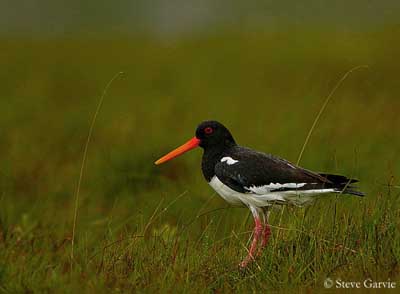
Eurasian Oystercatcher
Haematopus ostralegus
Charadriiforme Order – Haematopodidae Family
BIOMETRICS :
Length: 40-48 cm
Wingspan: 80-86 cm
Weight: M: 425-800 g – F: 445-820 g
LONGEVITY: Between 36 and 40 years
DESCRIPTION:
Eurasian Oystercatcher is the most widespread of the oystercatchers. Its elegant black and white silhouette and the red bill make it very distinctive among other waders.

Adult male in breeding plumage has black upper back, scapulars, upperwing coverts, head, neck and upper breast. On the wings, we can see a broad white wing bar becoming narrower and less regular towards the tip.
The middle and lower back, rump, uppertail coverts, lower breast and belly are white.
The tail shows black terminal band.
On the head, the long bill (75-76 mm) is orange-red with yellow-orange tip. Eyes are red with bright red eye-ring. Legs and feet are pink.
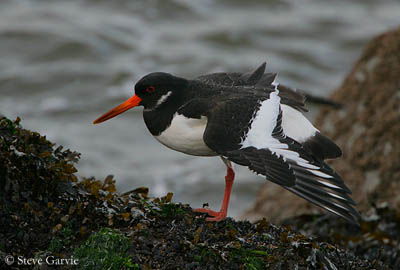
Adult male in winter plumage is almost similar, but it shows a conspicuous white semi-collar on foreneck. The bright red colour of bill and eyes is duller and legs are paler.
Female is similar to male but slightly larger with thinner and longer bill (80-81mm).
Juvenile resembles adults with duller bill, eyes and legs. The upperparts show buff-edged feathers.
It reaches its sexual maturity at 3 years for females and 4 years for males.
We can find four subspecies: H.o. ostralegus ; H.o. longipes ; H.o. osculans ; H.o. finschi.
They differ in range and mainly on bill length, size of the white wing bar and intensity of black on the upperparts.
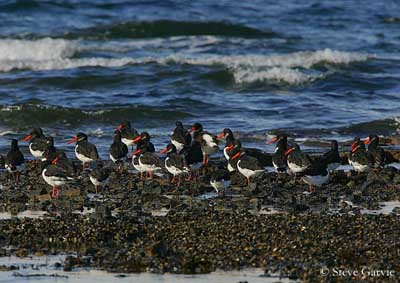
VOICE: SOUNDS BY XENO-CANTO
Eurasian Oystercatcher is very vocal, according to its behaviour, from contact calls to calls which accompany the different displays.
The most typical call is a shrill piping “kleep” or “ke-beep” often repeated. This call may be very complex and far-carrying, starting with accelerating trill and slowing down gradually.
It is used in aggressive behaviour between neighbours, and in defence of territory, frequently uttered during breeding season.
This piping is also used for establishing and maintaining hierarchies outside breeding season.
HABITAT:
Eurasian Oystercatcher breeds more on salt-marshes and beaches than on rocky coasts. It also may nest inland, in cultivated areas or along water.
During the non-breeding season, it is found in mudflats in estuaries, salt marshes, sandy and rocky shores.
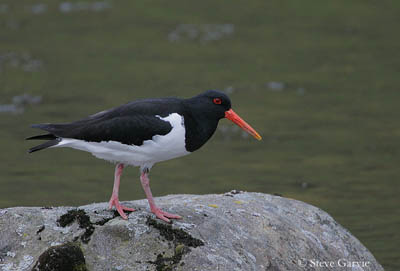
RANGE:
Eurasian Oystercatcher breeds in Western Europe, central Eurasia, Kamchatka, China and western coast of Korea.
It winters southwards, from North Africa to southern European coasts.
Inland breeders move to coast in winter.
BEHAVIOUR:
Eurasian Oystercatcher feeds mainly on bivalves, crabs, earthworms and insect larvae. It feeds by foraging on soft coastal substrates, coastal flats, rocky shores and inland. Preys depend on the feeding area.
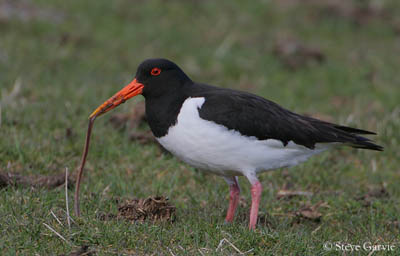
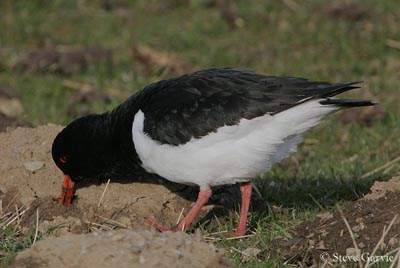
It uses several techniques such as hammering, in order to crack open the shells, and probing with the long bill which sensibility allows the bird to find the prey by touch rather than by sight.
It usually “attacks” the mussels when they are feeding themselves. At this time, the valves are gaping, making easier for the bird to sever the muscles holding the valves together. Several other items are attacked in the same way, when they move about over the rocks for foraging.
Eurasian Oystercatcher is monogamous, with strong fidelity to mate and breeding areas. It is very territorial during this period. The male performs aerial displays accompanied by melodious and regular “tii-tiiip”.
This species produces only one brood per season, due to the length of the cycle. But they will replace the brood if the eggs are lost.
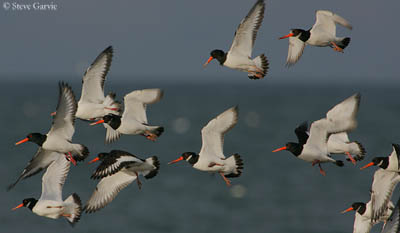
Eurasian Oystercatchers migrate southwards in winter. They travel in flocks of 25 to 70 birds in loose lines, both by day or by night. This species is strongly faithful to the wintering site. The distance between the stop-overs is probably less than 1000 km.
FLIGHT:
Eurasian Oystercatcher performs fast, direct, powerful flight. The flight display is “Butterfly-like” with stiff, slow and deep wing beats. It is very different from the usual flight.
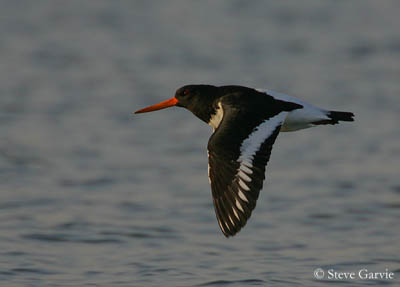
REPRODUCTION:
Breeding season occurs in April-May.
The nest is a scrape on the ground, lined or not. It is placed to provide good all-round visibility. The scrape is made mainly by the male, but female probably chooses the site. If the nest is lined, we can find shells and fragment of rocks in it, when made in coastal area. The nests situated inland are lined with small mammal’s droppings.
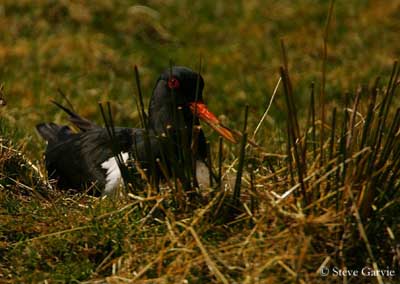
Female lays 2 to 5 cryptic-coloured eggs. Incubation lasts about 24 to 35 days, first by female while the male defends the nest-site, but later, the male’s contribution increases and both parents share it.
At hatching, chicks have cryptic down and they leave the nest very soon, within 24 hours. They are fed by their parents. They fledge about 33 days after hatching and they still depend on adults for food.
Young remain up to six months with their parents.
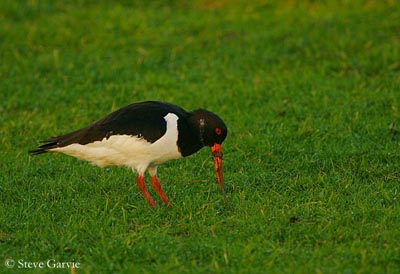
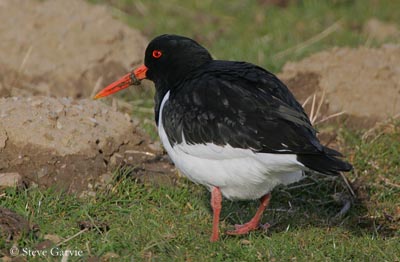
DIET:
Eurasian Oystercatcher feeds mainly on mussels and other bivalves such as limpets and whelks, crabs, earthworms and insect larvae, rarely fish.
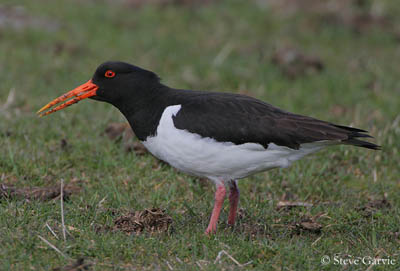
PROTECTION/ THREATS / STATUS:
Eurasian Oystercatcher’s populations have increased during the 20th century, after the decline observed during the 19th.
This species is not threatened at this moment.
Fr: Huitrier pie
All : Austernficher
Esp : Ostrero
Ital: Beccaccia di mare
Nd: Scholekster
Russe: Kulik-soroka
Sd: Strandskata
Photograps by Steve Garvie
His website: RAINBIRDER Photo galleries
Text by Nicole Bouglouan
Sources :
HANDBOOK OF THE BIRDS OF THE WORLD Volume 3 by Josep del Hoyo-Andrew Elliott-Jordi Sargatal - Lynx Edicions - ISBN : 8487334202
THE HANDBOOK OF BIRD IDENTIFICATION FOR EUROPE AND THE WESTERN PALEARCTIC by Mark Beaman, Steve Madge - C.Helm - ISBN: 0713639601
GUIDE DES LIMICOLES de D. Taylor - Delachaux et Niestlé - ISBN : 2603014080
Wikipedia (Wikipedia, The Free Encyclopedia)